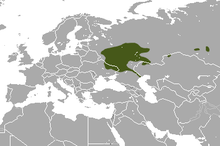Russian Desman
| Russian desman | |
|---|---|
 |
|
| Scientific classification | |
| Kingdom: | Animalia |
| Phylum: | Chordata |
| Class: | Mammalia |
| Order: | Soricomorpha |
| Family: | Talpidae |
| Subfamily: | Talpinae |
| Tribe: | Desmanini |
| Genus: |
Desmana Güldenstädt, 1777 |
| Species: | D. moschata |
| Binomial name | |
|
Desmana moschata (Linnaeus, 1758) |
|
 |
|
| Russian desman range | |
The Russian desman (Desmana moschata) (Russian: выхухоль vykhukhol') is a small semiaquatic mammal that inhabits the Volga, Don and Ural River basins in Russia, Ukraine and Kazakhstan. It constructs burrows into the banks of ponds and slow-moving streams, but prefers small, overgrown ponds with abundance of insects, crayfish and amphibians. The Russian desman often lives in small (usually not related) groups of two to five animals, and appears to have a complex (but largely unstudied) communication and social system.
The Russian desman is one of two surviving species of the tribe Desmanini, the other being the Pyrenean desman. Despite its outward similarity to muskrats (a rodent), the Russian desman is actually part of the mole family Talpidae in the order Soricomorpha. Like other moles, it is functionally blind and obtains much of its sensory input from the touch-sensitive Eimer's organs at the end of its long, bilobed snout. However, the hind feet are webbed and the tail is laterally flattened —specializations for its aquatic habitat. The body is 18 to 21 cm (7.1 to 8.3 in) long while the tail is 17 to 20 cm (6.7 to 7.9 in) in length. Easily the largest species of mole, it weighs 400 to 520 g (14 to 18 oz).
...
Wikipedia

